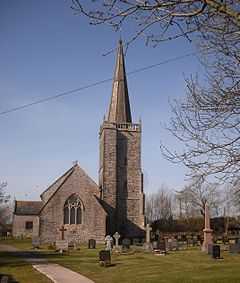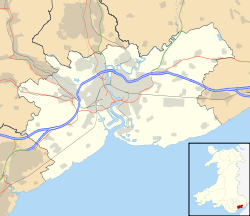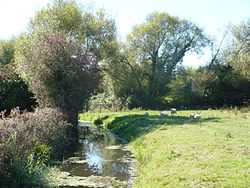Nash, Newport
| Nash | |
| Welsh: Trefonnen | |
 St. Mary's Church, Nash |
|
 Nash |
|
| Population | 281 (2001 census[1]) |
|---|---|
| Principal area | Newport |
| Ceremonial county | Gwent |
| Country | Wales |
| Sovereign state | United Kingdom |
| Post town | NEWPORT |
| Postcode district | NP18 2 |
| Dialling code | 01633 Maindee exchange |
| Police | Gwent |
| Fire | South Wales |
| Ambulance | Welsh |
| EU Parliament | Wales |
| UK Parliament | Newport East |
Coordinates: 51°32′56″N 2°56′46″W / 51.548917°N 2.946175°W

Nash (Welsh: Trefonnen) is a village and community parish to the south of the city of Newport, south-east Wales, in the Liswerry ward.
Origin of the name
The name is thought to originate from a contraction of "An Ash" (tree), meaning literally `place of the ash tree(s)'. This is supported by its appearance in deeds as "De Fraxino" (fraxinus was the Latin name for the ash tree).[2]
The Welsh name is Trefonnen, given in older sources as Tre'r onnen, also meaning Town (tref) of the Ash (onnen).
Location
Nash lies a mile or to the south of the built-up area of the city of Newport, on the Caldicot Level, a large area of land reclaimed from the sea and crossed by drainage channels and reens.[3] In addition to the village itself, the parish contains Uskmouth power station [4] and part of the Newport Wetlands Reserve,[5] including its Visitors Centre which was opened in 2008.[6]
The City of Newport campus of Coleg Gwent (commonly referred to as 'Nash College') is actually in the neighbouring parish of Liswerry.
Together with the neighbouring parishes of Goldcliff and Whitson, Nash is one of the "Three Parishes" which have long been treated as a unit - geographical, socially, economically and ecclesiastically.
The parish is bounded to the south by the sea (Bristol Channel) to the east by the lower reaches of the River Usk and to the north by Liswerry and the Llanwern Steelworks site. To the west lie Goldcliff and Whitson.
History
In 1901 the only four private residents are listed as Mrs Morgan at "Greenfield", Mrs Morgan at "The Elms", Rev. C. W. Triton (Baptist, but curiously no separate residence given) and Miss Ester Wilcox at "Decoy Pool". Some twenty nine commercial interests include mostly farmers (22) but also William German, blacksmith and wheelwright, at "Pye Corner", Mrs Sarah Jones, publican at "Waterloo Inn", John Skuse, shop-keeper at Broadstreet Common, Edward Tamplin butcher at "Box Cottage", David Thomas farm bailiff to Mr. James Thomas at "Pye Corner Farm", John Watkins, butcher and Lewis Williams, mason at "Ash Cottage".[7]
A large part of the village, including Farmfield House, was lost in the construction of the Uskmouth Power Station and the adjoining huge ash-pits in 1959. Although the main part of the village centres around the church in West Nash, much of the village is set along the wide Broadstreet Common, accessed via Pye Corner or Straits Lane, and which provides the more direct route to Whitson and Redwick. For many years the German family were the village blacksmiths at Pye Corner with the premises eventually becoming a petrol station. The site is now occupied by the offices of the Caldicot and Wentloog Levels Internal Drainage Board.[8] The village had its own small infant school, built in 1877 [7] on West Nash Road, until the 1970s.
The Church
The parish church of St. Mary the Virgin in West Nash, dating originally from the 12th century,[9] is an important Grade I listed church,[10] notable for its fine tower and spire and has been called "the Cathedral of the Moors". The church belonged to Goldcliff Priory in 1349 when Robert Arney was instituted to the benefice. The Arney family, in the time of Charles II, left a cottage and six acres of land, called "The Poor's Six Acres", for the support of the poor of the parish.[11]
The church was largely rebuilt during the 16th century.[12]
The only remains of the Norman church is the North Wall of the chancel and the Squint. An unusual feature, the Squint or Hagioscope was used to enable those with leprosy, smallpox or other such diseases, to see or participate in the service without endangering the rest of the congregation with infection. The tower is unusually located on the north side of the chancel. The church is thought to originally have been much larger, incorporating a North aisle.[11]
In the early years of the 20th century the floor of the bellringer's room was used as a temporary mortuary for the bodies of five sailors who had been drowned at sea, in a violent storm, near the East Usk Lighthouse. Four of the sailors had been found lashed to the mast. During World War II the church saw congregations of 400.[11] The interior, following restoration in 2004–2005, is notable for its complete set of 18th century furnishings, with box pews, a three-decker pulpit and a western gallery. In the fields to the south of the neighbouring Church Farm are ancient tumuli, the vestiges of some ancient, possibly mediæval, dwelling or chapel.
Baptist chapel

At Pye Corner the former Baptist chapel, with its small graveyard, still stands in good repair. The chapel opened in 1820 with seating for 125. Its congregation included residents of what was then the hamlet of Liswerry, a mile or so distant (about 2 kilometres).
Some of the congregation found it more convenient to attend Liswerry Baptist Church when it opened in 1889, the same year that Liswerry was incorporated into Newport under the provisions of the Newport (Mon.) Corporation Act, 1889. A steady decline in attendances at Nash led to only five remaining members in 1988. The chapel closed soon afterwards.
The chapel contained a covered immersion baptismal font and a rare pedal organ built and played (well into his nineties) by the late Mr. A. W. Haime (Master Baker) of Earlswood, Shirenewton.[13] In 2006 a planning application was made to Newport City Council to convert the building into a dwelling house with vehicular access. It is now in private ownership, although unhindered access to the graveyard remains.[14][15]
Amenities
_-_geograph.org.uk_-_1366553.jpg)
To the north of church, at the end of St. Mary's Road, The Waterloo public house is a tenanted free-house notable for the fact it is owned by the parish council. A modern Community Hall has been built nearby.
Located at the edge of the Newport Wetlands Reserve,[16] East Usk Lighthouse [17] provides a notable landmark. Parts of Nash are designated a Site of Special Scientific Interest SSSI.[18]
The village enjoys a regular public bus service provided by Veolia Transport Cymru.
The local newspaper is the South Wales Argus which is published in Newport.
The village skyline has recently been transformed with the installation of two 2.5-megawatt wind turbines, on the site of chemical company Solutia UK Ltd, which will supply up to one-third of the facility's electricity needs.[19]
Present-day Nash

Several road schemes have proposed a southern relief motorway loop for Newport, as a way of mitigating the congestion of the existing M4 motorway. Many of these schemes have involved intrusion, to a greater or lesser extent, into Nash. As a result Nash Community Council became a member of the "Campaign Against the Levels Motorway" (CALM) Alliance formed to oppose such schemes by the Friends of the Earth Cymru.[20] The bypass scheme was eventually cancelled in July 2009.[21]
In June 2010 a public meeting was held at the village Community Centre to discuss proposals for a waste incinerator in Newport. Members of the "Stop Newport Incinerator Campaign (SNIC)" organsised the meeting to explain to residents the possible development on Bowleaze Common land south of Llanwern steelworks.[22]
Government
The area is governed by the Newport City Council and the Nash, Newport community council.
References
This article contains public domain material from J. A. Bradney's History of Monmouthshire (1904).
- ↑ Office for National Statistics Parish Headcounts: Nash
- ↑ Bradney, Sir Joseph, A History of Monmouthshire, Vol 4 part 2: The Hundred of Caldicot (Part 2). pub 1914, reprinted 1994, Merton Priory Press.
- ↑ Reen near Nash, Newport:: OS grid ST3483 :: Geograph Britain and Ireland - photograph every grid square!
- ↑ Uskmouth powerstation:: OS grid ST3283 :: Geograph Britain and Ireland - photograph every grid square!
- ↑ Newport Wetlands Visitor Centre:: OS grid ST3383 :: Geograph Britain and Ireland - photograph every grid square!
- ↑ Newport centre is a wetland wonder!
- ↑ 7.0 7.1 Kelly's 1901 Directory
- ↑ Caldicot and Wentloog Drainage Board
- ↑ 900 year old Newport church
- ↑ "St Mary the Virgin Church at Nash" at geograph.org.uk
- ↑ 11.0 11.1 11.2 Hando, F.J., (1958) "Out and About in Monmouthshire", R. H. Johns, Newport.
- ↑ "900-year-old Newport church to tell its story", South Wales Argus, 6 August 2010. Retrieved 22 January 2014.
- ↑ "Nash Baptist Chapel at Pye Corner" at geograph.org.uk
- ↑ http://www.saqqara.demon.co.uk/familytree/Nash%20Baptist%20Church.htm
- ↑ "Former Nash Baptist Chapel, Pye Corner" at geograph.org.uk
- ↑ Newport Wetlands Plaque:: OS grid ST3383 :: Geograph Britain and Ireland - photograph every grid square!
- ↑ Newport Wetlands, East Usk Lighthouse:: OS grid ST3382 :: Geograph Britain and Ireland - photograph every grid square!
- ↑ City of Newport Countryside and Parks
- ↑ Solutia in green bid to blow aawy high energy bills at walesonline.co.uk
- ↑ Friends of the Earth:Protest to greet new M4 exhibition
- ↑ M4 Toll Newport Bypass at cbrd.co.uk
- ↑ Incinerator plans up for discussion at southwalesargus.co.uk